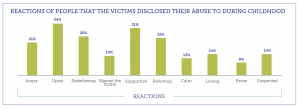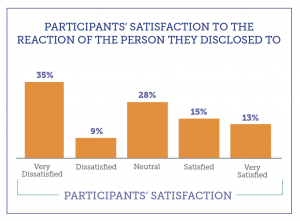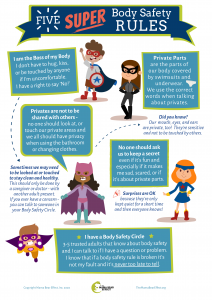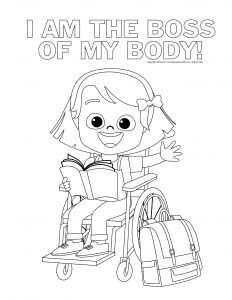One of the most damaging misconceptions regarding child sexual abuse is the belief that children will, instinctually, disclose abuse. Many adults are unaware of how important it is to clearly educate children about sexual abuse so they can know what it is. Furthermore, many lack an understanding of the manipulation that often occurs in an abusive relationship, which confuses children and keeps the abuse from being exposed.
What Can We Do Better?
In the Parental and Caregiver Perspective study, we surveyed parents to gain an understanding of their views regarding child sexual abuse prevention. We also asked those who had a history of sexual abuse about their experience, discovering that those who were educated in body safety as children did not disclose their abuse any sooner than survivors who were not educated. There appears to be a disconnect in awareness for a number of years – many abuse prevention programs focused mainly on children, often with a “stranger danger” approach, with minimal or no education geared towards adults.
A research study in 2021, hosted a 12-person focus group of adult survivors to better gain an understanding of what children need to improve disclosure. To summarize the identified conditions were:
- Adults Making it Possible to Tell
- Adults Daring to Consider the “Unthinkable”
- Conveying Knowledge of CSA That Facilitates Understanding
It is a common experience for survivors to not be believed and blamed for the abuse. In order to prevent child sexual abuse, which is roughly estimated to affect 1 in 10 children (contact-only abuse) to historical rates of 25% of women and 16% of men and the vast-majority of children with disabilities, adults need to be prepared for disclosures, and create environments that prioritize safety and encourage conversations about safety & appropriate behaviors with children.


The question is, as protective adults – how can we increase disclosure rates, and even possibly prevent sexual abuse by improving communication with children?
How can we increase disclosure rates or even prevent sexual abuse before it happens?
Normalizing Body Safety Conversations
Just as children need regular reminders about many behaviors relating to health and safety – brushing their teeth, buckling a seatbelt, the buddy-system etc., sexual abuse prevention (or “Body Safety”) is no different. Body Safety encompasses not just the ‘act’ of sexual abuse but also the precursors that can desensitize a child to abuse.
- Bodily Autonomy – teaching children that all people have a right to their own bodies and to decline interactions/touches that are unwanted. Most common, the right to not engage in affection – even with family/friends. Parents and caregivers will often see this with their toddlers seeking control over how often they are kissed, hugged, or held. Some may see this as “hurtful” but it is important for even toddlers to know they do not have to submit to affection – with anyone.
- Consent – understanding the importance of respecting the autonomy and boundaries of others, asking permission (not just with bodies, but also personal belongings), stopping an unwanted behavior, and exercising emotional competence to assess whether someone else is happy/sad/angry etc. so that even if the word “no” isn’t expressed, we can read body language to improve our ability to show compassion toward others.
- Private Parts & Privacy, keeping the intimate parts of our body private – not exposing one’s genitals, buttocks, breasts etc. and giving people privacy while changing, using the bathroom etc. Each family may have their own understanding of what it means to have privacy, but it is still important to distinguish situations that should have privacy. For example, in some families, young siblings may share a bathtub, but adults (like a babysitter, aunt/uncle, teacher) should always have privacy when they are dressing or using the bathroom.
- Secrets – no matter how innocent a secret may seem, when children are encouraged to keep secrets from the protective adults in their life, it weakens the bond and can enable perpetrators to gain control of a child. Instead, we promote that children be taught the difference between surprises, which are happy and only kept quiet for a short time before being shared openly, and a secret, which is not appropriate and should be told.
- Abuse is Never a Child’s Fault – while it may seem like a given to adults, children may internalize or externally be told by a perpetrator that they are a willing participant, that there will be negative consequences for telling, etc. Disclosing sexual abuse for adults is extremely difficult and uncomfortable, it should not surprise anyone that children will also struggle with a variety of emotions and fears. Children need to be reminded often that we will support them; they also need to see us respond calming in other situations so they can have the confidence we will not overreact or respond in a way that will make them regret or possibly rescind their disclosure. Children should be told regularly that it is never too late to tell – most children will experience abuse more than once and, if told they “must tell right away” they may internalize that message to mean that it was their failure for not telling after the first time.


So, how do we check-in?
As a family that has invested time on the issues of Body Safety summarized briefly above (learn more at our Rock Talk section for Toddlers, Grade School, Teens, and Children with Disabilities), a body safety check-in is intended to touch base with our children, especially if they have spent time alone with others, at a playdate, with a family member babysitting them, at school or camp, etc. However, this should occur during a time with minimal distractions – not driving home with eyes on the road, or when a child is playing video games, but when both parent and child can make eye contact and are in a relaxed environment. Perhaps sitting outside together, but most often parents may find this occurs at bedtime – when children are processing their thoughts about the day and are eager to delay going to sleep as much as possible.
The goal of a body safety check-in is to remind children, casually, about the importance of body safety and provide an opportunity to discuss situations that may border on inappropriate or abusive. If a child has spent time away from their parent, to check-in on how they felt about the experience and remind them that we value their safety and comfort.
A body safety check-in may sound like this (with breaks, of course, so your child can respond and it doesn’t feel like an interrogation):
“So, how was your time spent at Xyz’s house?
What did you do while you were there?
Did you do anything different or new that we don’t do at home?
Who was there?
Did you feel safe?
Did you go on the computer or their tablet?”
Or it may start like this…
“How was school today?
Do you like your teachers?
How was it on the playground?
And, I have to remind you – I know that in the bathroom, inappropriate stuff can happen. Sometimes kids might peek in the stalls or even show their privates. It’s important to tell me and your teacher if something like that happens. Has anything that seemed confusing or uncomfortable every happened to you at school?”
On occasion, it can include asking a child what the body safety rules are, so we can assess that their level of understanding.
It can end with…
“I want you to know I love you so much, and that no matter who or what, I want to keep you safe.”
“I might not know who would do something inappropriate, but you should never feel afraid to talk to me. You matter more to me than anything.”
“I see stories in the news of kids who told when someone broke a body safety rule, this kind of stuff can happen and it would never be too late for you to tell.”
For teens, it may be much more direct…
Does your manager at work treat you with respect? Remember, you do not have to tolerate any kind of harassment from anyone.
How was your night? Remember, I’m only a text away if you need an out from a situation.
*Tweens and Teens most especially need understanding and empathy, even if they’re seeking independence, they are very much still need a safe adult to talk to. If there is a grandparent, aunt/uncle, or family friend who can help fill this role, children do benefit from having more than one caring adult that checks on them and makes themselves available.
Expect disclosures of inappropriate behaviors, and be prepared.
Especially as children spend time with peers, there will likely be an increase of inappropriate behaviors – exposing of body parts, nonconsensual interactions, secrets, exposure to pornography/adult content etc. Not all of this will be abusive, but it may justify increased supervision, review of boundaries, conversations with other parents/adults, etc. More importantly, there may be certain grooming behaviors that children may identify before a potentially abusive situation develops. Remaining calm and allowing children to talk without interruption helps to keep communication channels open and welcome.
Possible grooming behaviors may include but are not limited to:
- Increased affectionate interactions/touching
- Adults sharing overly-personal details of their life
- Sexualized comments/jokes/compliments towards and/or in front of children
- Interest in communicating privately
- “Accidental” touching of private parts
- Adults that spend excessing time with children or seem to have a “favorite” child
- Adults that give special treatment or gifts
- Encouragement of secrets
The challenge with grooming behaviors is that they are not always obvious – many behaviors can (intentionally) mimic caring, friendly behaviors. Some adults may, unknowingly, engage in behavior that can confuse children and weaken their ability to identify inappropriate behaviors. For example, a family member may want to hug or touch a child that says “no” or tell a child that it’s a ‘secret’ to give them something. As protective adults, we may question ourselves and the situation, not wanting to unnecessarily express concern. However, all types of potential grooming behaviors can confuse children, they may need to be addressed with the parties involved, and require increased attention.
Check-ins are part of Positive Parenting
Even if a child never experiences an inappropriate or abusive situation, having regular 1:1 conversations with our children is a great form of bonding and empowerment for children. All children need to feel valued, heard, and have the opportunity to talk to someone who wants the best for them. When children do not have safe adults in their life to connect with, they are more likely to be targeted by perpetrators that can sense and exploit their human need for connection.
Further Resources
- Rock The Talk Infants & Toddlers
- Rock the Talk Grade School
- Rock the Talk® – Tweens & Teens
- Rock the Talk Children with Disabilities
- Understanding Abusers
- Red Flags of Child Predators
- Advice from Families Affected by Abuse
- Sexual Behaviors in Youth
- Minimizing Opportunity
- When to Speak Up
- Suspected Abuse
- Resources for Order





